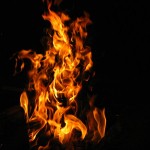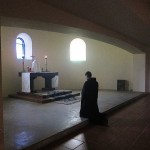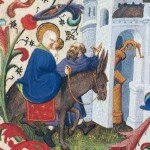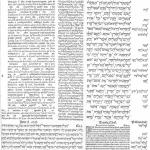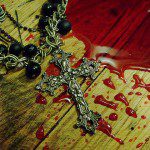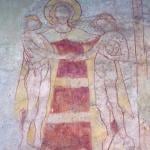 In reading Frank Viola and Leonard Sweet’s Jesus A Theography I enjoyed the second chapter the most. Frank and Leonard aim to show how Jesus Christ is echoed and reflected in every part of the Scriptures. They build up a full picture of Christ the Lord–not just by trying to reconstruct the “historical Jesus” (that exercise usually ends up with a portrait of Jesus that looks remarkably like the person constructing the portrait) but building up a multi-faceted understanding of Jesus the God-Man.
In reading Frank Viola and Leonard Sweet’s Jesus A Theography I enjoyed the second chapter the most. Frank and Leonard aim to show how Jesus Christ is echoed and reflected in every part of the Scriptures. They build up a full picture of Christ the Lord–not just by trying to reconstruct the “historical Jesus” (that exercise usually ends up with a portrait of Jesus that looks remarkably like the person constructing the portrait) but building up a multi-faceted understanding of Jesus the God-Man.
In chapter two they explicate the Garden of Eden story in the light of the tabernacle–the Jewish portable temple–and Solomon’s temple in Jerusalem. So they write:
In Genesis 2:15, God commanded Adam to cultivate and keep the garden. The Hebrew word for cultivate is abad, and the Hebrew word for keep is shamar. These same Hebrew words are used to describe how the priests cared for the tabernacle of Moses. (The tabernacle was a precursor to the temple of Solomon.) The priests were to cultivate (abad) and keep (shamar) the tabernacle. In addition, we are told that God walked in the garden (Hebrew, hawlak) during the cool of the day. God also walked (hawlak) in the midst of the temple.
The meaning is clear. The garden was a temple for God. Like the temple, the garden was the joining together of God’s space and man’s space—the intersection of the heavenly realm and the earthly realm. For this reason, Isaiah called it “the garden of the Lord,” and Ezekiel called it “the garden of God.”
I was immediately intrigued by the idea that the Jewish prophets understood the temple to the “garden of God” and therefore worship in the temple was a way for man to “get back to the garden” and to have the innocence of Eden restored. As a Catholic I couldn’t help remembering the beautiful churches in our rich heritage. As Frank and Leonard continued to explain I saw detailed parallels with Catholic church traditions in art and architecture. Here is the next part of their text in chapter two with my interpolations in red.
The Garden and the Temple of Israel: The garden of Eden faced east. The tabernacle and temple faced east. Catholic churches face east. The garden was placed on a mountain. .The temple was also placed on a mountain. Many Catholic churches are placed on the highest point locally. The trees of the garden were pleasing to the eye. In like manner, the temple of God is always associated with beauty. Catholic churches are famously beautiful. Palm trees, pomegranates, lily blossoms, and open flowers were graven in the walls of the temple. These all contain echoes of the garden. Catholic churches–especially cathedrals–were designed to have a forest in mind. The pillars were like trunks of trees–the beautifully decorated fan vaulting and arches were the spreading cover of the branches. The tops of the pillars were carved with different motifs of leaves and floral decoration. The walls were often decorated with bright colors and floral patterns making the interior of the church like a richly abundant garden. The cherubim (plural of cherub) were embroidered into the curtains of the tabernacle and temple, guarding the Holy of Holies. Images of angels abound in Catholic churches–in the stained glass, in the carvings, at the doors and windows. The cherubim were also placed on both sides of the bloodstained mercy seat of the ark of the covenant, guarding it just as they guarded the garden of Eden. Many Catholic churches have kneeling angel statues at the side of the altar or at the side of the tabernacle. This is why the First Testament says that the Lord dwells in the midst of the cherubim. Gold, silver, and precious stones filled the temple. Gold, pearl,and precious stones flowed from the garden of Eden. Our sacred vessels must be made of precious metals and are often adorned with precious stones. …It is no accident that the ancient Hebrews and rabbis regarded the garden of Eden to be God’s first temple. Both the tabernacle of Moses and the temple of Solomon constantly remind us of the garden…In the temple, God’s glory and presence dwelled on the ark of the covenant in the Holy of Holies. The Holy of Holies was a perfectly cubed room. It grew in size from its dimensions in the tabernacle to its dimensions in the temple of Solomon. Catholic churches are designed on the lines of the temple–with an outer court, an inner sanctuary and the Holy of Holies which is the locked tabernacle where the consecrated bread is contained which is the Body of Christ. Thus the presence of the Almighty is enshrined in the Holy of Holies in every Catholic church.
What does all this mean today? First of all, it is amazing and fantastic that Evangelical writers are becoming more open to this very fruitful and exciting way of reading Scripture. It has usually been a more ‘Catholic’ way to read the Scriptures seeing types and symbols and pointers to Christ in this way. While it is exciting that Evangelical writers are opening the Scriptures in this ancient and abundant manner it is also sad that we Catholics seem to have lost the knack.
The tragedy of much of modern Protestant Biblical scholarship has been its reliance on modern ‘scientific’ methods of analysis and dry critical nit picking and academic debate rather than prayerful, creative and insightful scholarship which helps to bring the Scriptures alive. Too often in recent years Catholic scholarship has gone the way of the liberal Protestant critical scholarship and lost its own identity and power. Too much Catholic Biblical scholarship has become Protestant, so now its a delight to find Protestants who are reading the Bible in a very traditionally Catholic way and finding much there that is fruitful and exciting and dynamic in our understanding of Christ the Lord.
The other thing this passage shows us is an intriguing difference of understanding between Catholics and Protestants about church buildings and therefore also about physical stuff. After reading this chapter I wanted to say to Frank and Leonard–“If all this is true why are your churches just bare preaching barns?” Don’t you see that the Catholic church is the new Israel? In the Catholic church all these great symbols and connections are still alive! Go into a Catholic church. You will see the Holy of Holies for there is the tabernacle. You will see the incense being offered before the altar. You will see a sacrificing priest in splendid robes of his office. There you will see the cherubim enthroned before the mercy seat which is the altar. There you will see the floral decorations, the trees and flowers that remind you of Eden. There you will see the font–which holds the water of life and symbolized the rivers of mercy.”
“Why don’t you have these things in your churches?” I wanted to ask. “Why are your churches just bare preaching halls?” But then I was stymied because I thought, what if anyone reading this were to go into a modern Catholic church and they would probably find not much more than a bare preaching hall as well.
So this passage from Frank and Leonard’s book reveals (and my interpolations from a Catholic perspective) how much we Catholics are ignorant of our own traditions and ignorant of these rich understandings of the Old Testament (whoops! I mean the “First Testament”!) which shed so much light not only on the Lord himself, but on our rich traditions of Catholic art and architecture.
Clearly those who have designed Catholic churches over the last fifty years are either completely ignorant of these rich and fascinating details which connect the church building and its decorations with the Bible and, more importantly with the Lord himself. Not only have the architects and designers been ignorant of the meaning of these details, but the Catholic priests themselves–who have overseen the building of the execrable modern Catholic churches–have been ignorant of these details. I’d bet my life that those who designed the modern Catholic churches that look like a cross between a parking garage and a flying saucer hadn’t a single clue what all the decorations and architecture in the more traditional churches meant. For them it was no more than outdated wallpaper which you needed to strip off in order to re-paint.
What Frank and Leonard have accomplished in this short chapter is to show us Catholics, on the one hand, the richness of our 2,000 year old heritage, and on the other hand, hold up a mirror to the depravity and poverty of our current crop of church buildings.
There is more to it than that. What Frank doesn’t do in his book (and it’s okay that he doesn’t because it is beyond the scope and theme of this particular book) is explore the difference in attitude to the physical world and the physical means of worship that are revealed in the Old Testament and modern Evangelical theology and worship. Read More.



